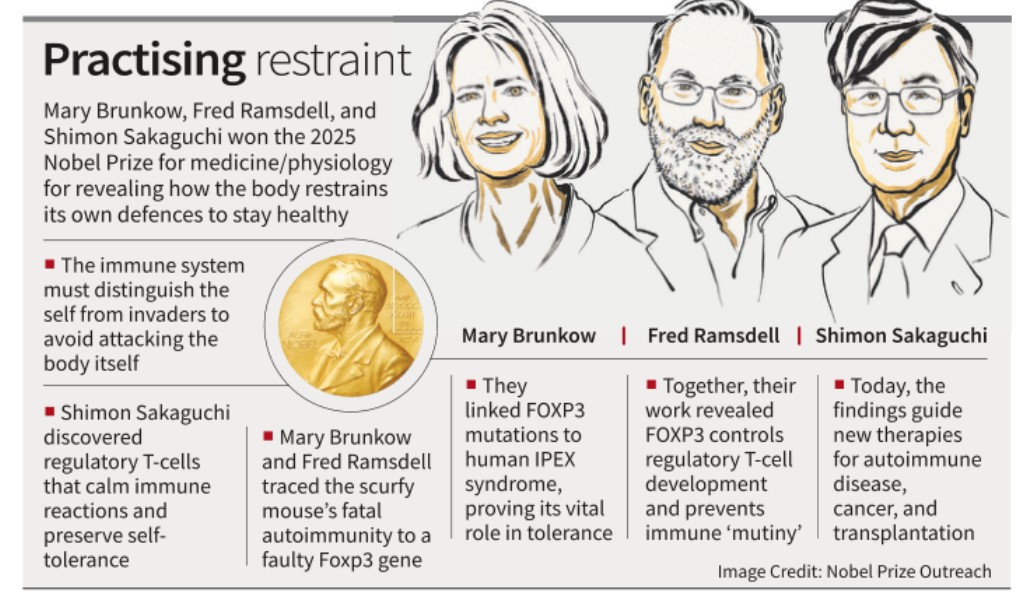Introduction
For decades, the immune system was viewed as a binary apparatus either attacking foreign invaders or remaining silent toward the body’s own cells. This year’s Nobel laureates, Mary Brunkow, Fred Ramsdell, and Shimon Sakaguchi, dismantled that simplistic view by uncovering the critical role of regulatory T-cells (Tregs) and the FOXP3 gene in maintaining self-tolerance. Their findings fundamentally redefined how scientists perceive immune regulation and opened the path for precision immunotherapy — one of modern medicine’s most promising frontiers.
The Science of Self-Tolerance: Why It’s in the News
The Nobel Committee’s recognition of research on regulatory T-cells (Tregs) and FOXP3 marks a watershed moment in immunology. For the first time, the prize acknowledges discoveries that explain how the immune system prevents itself from attacking the body. The work explains why autoimmune disorders like Type 1 diabetes, rheumatoid arthritis, and lupus occur when this “self-check” mechanism fails. It also connects molecular immunology to emerging therapies for cancer and transplantation. This is a landmark shift from viewing immunity as mere “defence” to seeing it as a balance of activation and restraint, a concept that has redefined global biomedical research.

How the Nobel-winning Discovery Unfolded
- Early Understanding: In the 1990s, immunologists believed that self-reactive T-cells were deleted during their maturation. However, this could not explain why some autoreactive T-cells still existed in healthy people.
- Sakaguchi’s Breakthrough (1995): Identified a subset of CD4⁺ T-cells whose removal in mice led to multiple autoimmune disorders. Restoring them prevented disease — proving they act as regulators of immune overreaction.
- Discovery of FOXP3 Gene: Brunkow and Ramsdell, working in an industry lab (Celltech Chiroscience), traced severe autoimmune disease in male “scurfy” mice to a gene mutation on the X chromosome. They named it FOXP3.
- Human Correlation: Soon, mutations in FOXP3 were linked to lethal autoimmune syndromes in boys, confirming its pivotal role in human immune regulation.
How These Discoveries Transformed Immunology
- Redefining the Immune System: The immune system is now seen not as an on/off mechanism but as a dynamic ecosystem that balances activation (attack) with restraint (tolerance).
- New Therapeutic Frontiers:
-
- Autoimmune Diseases: Efforts are underway to expand or stabilise Tregs to curb harmful immune activation without broad immunosuppression.
- Transplant Medicine: Infusion of engineered Tregs improves graft acceptance and reduces rejection rates.
- Cancer Research: Selective depletion or reprogramming of tumour-associated Tregs enhances anti-tumour immunity without triggering autoimmunity.
From Lab to Life: The Translational Challenge
- Incremental Progress: Immunologists warn against overestimating breakthroughs. The immune system has multiple overlapping control layers, making clinical translation slow.
- High Cost Barrier: Cell-based therapies remain expensive, leading to inequitable access between high- and low-income populations.
- Ethical and Policy Dilemmas: Who gets access first? How do we regulate genetic manipulation or Treg engineering? These questions highlight the intersection of science, ethics, and public policy.
Private Sector and Scientific Innovation
- Industrial Discovery: The fact that Brunkow and Ramsdell made their discoveries in an industry setting (Celltech Chiroscience) underscores the potential of private-sector-led innovation in fundamental science.
- Public–Private Synergy: It reinforces how collaborations between academic research and biotech industry can accelerate discovery and application, a model India can emulate in its biotechnology policy framework.
Broader Implications for India and Global Health
- Indian Relevance: India’s growing burden of autoimmune diseases (such as lupus, celiac, and thyroiditis) highlights the need for indigenous immunogenetic research.
- Policy Perspective: Translating such research into affordable therapies aligns with National Biotechnology Development Strategy and Ayushman Bharat’s preventive healthcare goals.
- Global Impact: These discoveries open a new era of personalised immunotherapy, integrating molecular biology, bioethics, and equitable access.
Conclusion
The 2025 Nobel Prize reminds the world that progress in science often lies not in creating new weapons against disease but in understanding balance, the balance within nature and within ourselves. The discovery of Tregs and FOXP3 has rewritten textbooks, inspired therapies, and expanded our conception of what “self” and “immunity” truly mean. For policymakers and scientists alike, it represents the future, a fusion of molecular precision, ethical responsibility, and social justice.
PYQ Relevance
[UPSC 2021] The Nobel Prize in Physics of 2014 was jointly awarded to Akasaki, Amano and Nakamura for the invention of Blue LEDs in the 1990s. How has this invention impacted the everyday life of human beings?
Linkage: Both the 2014 Nobel for Blue LEDs and the 2025 Nobel for Treg–FOXP3 discovery represent paradigm shifts where scientific breakthroughs moved from lab theory to real-world transformation — the former revolutionised energy efficiency, while the latter is redefining human health and immune regulation.
Get an IAS/IPS ranker as your 1: 1 personal mentor for UPSC 2024

